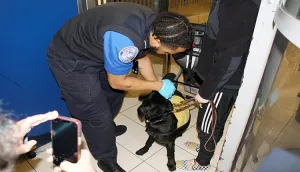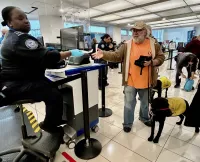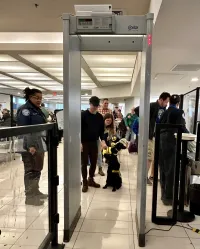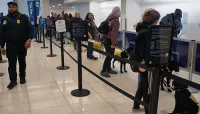
Puppy fever hit Ronald Reagan Washington National Airport (DCA) when two dozen service dogs in training went through TSA screening for the first time.
In conjunction with National Puppy Day, TSA screened 24 puppies and their trainers from the Guide Dog Foundation for the Blind and America’s VetDogs® whose missions are to help people with physical disabilities, individuals who are blind or have low vision, and veterans suffering from PTSD.
June Forte is TSA’s customer support quality improvement manager at DCA and launched the dog screening program over ten years ago. She said most of the pups were four to eight months old.
“I find immense joy in assisting with the training of puppies,” said Forte. “Witnessing the remarkable work these precious animals perform for humans is truly awe-inspiring. Being involved in their training is both an honor and a blessing.”
TSA officers worked with the dogs as they came through the checkpoint to acclimate the future guide dogs with an important piece of the airport experience – the security checkpoint.
“I screened every puppy thoroughly and efficiently as if they were actually accompanying their person with a disability, although it was just practice,” Officer Deyana Francis said. “This means never asking the passenger to remove their service animal’s vest. The vest lets the puppies know they are working. If you ask them to remove it, they will no longer know they are working and will assume it’s play time.”
The exercise helps the canines and their trainers know what to expect when the dogs and the people they are trained to guide return to the airport to take a real flight.
“The key goal for this training was to prepare the service puppies for actual travel through an airport,” noted Francis, who joined TSA in May 2022. “The puppies were able to practice being screened at our checkpoints and see what it’s like to walk down a jet bridge onto a plane.”
It was also a great opportunity for DCA’s TSA officers to hone their screening skills.
“It prepares us all for real-life situations,” Francis said. “Service animals come through airports quite frequently, and I believe this was an amazing training everyone should take part in.”
The dogs also had the opportunity to sniff around the airline check-in counters and baggage carousels, and the TSA DCA team arranged for the puppies and their trainers to board an aircraft.
Like Francis, TSA Officer Chelsea Green played a significant role in the experience, explaining the key goals were to “assist the passengers with their guide dogs” and “give clear and precise advisements to the passengers during each stage of the screening process.”
“Offer screening support on the designated checkpoint to ensure the efficiency of the entire checkpoint screening operations wasn’t compromised,” added Green, a TSA officer since February 2019. “And definitely make it fun.”
Green always takes pleasure when screening dogs and their handlers.
“I get to meet new people, and I love animals,” she noted. “I get to use my skill sets, both personal and professional, to integrate them into the screening process.”
“The orientation session was a hit with the dog trainers, the TSA officers and, of course, the dogs,” proclaimed John Busch, DCA’s TSA federal security director. “The collaborative effort benefitted the guide dogs, the airport and TSA and will go a long way to ensuring the dogs and their eventual owners will have a smooth checkpoint experience in the future.”
By Don Wagner, TSA Strategic Communications & Public Affairs



